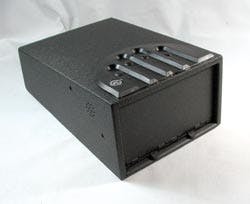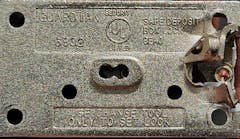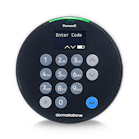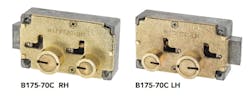The development of home/office safes enables people to purchase safes for specialized applications. For example, the fire safe became a necessary luxury when individuals wanted to keep personal papers in a "safe" home or office environment. Burglary safes enable people to keep their expensive jewelry, cash, bond, etc., "safe at home" and available 24 hours a day instead of during banker's hours in a safety deposit box.
The home/office safe has progressed to a new level, which I call "Personal" safes. A "Personal" safe is compact, portable, and designed to protect a single type of item, for example, a gun safe or a laptop safe. Most of these safes are large enough for additional personal items such as an iPod, PDA, and/or personal gaming unit. These safes must be mounted to a solid surface because they are light enough to be carried away. Each of the following safes has factory-drilled anchor holes. This way, the safes can move with a student into school housing in order to protect his or her possessions.
As more people own guns for safety, many purchase a specialized safe that satisfies three criteria for gun owners. The gun must be loaded. The gun must be locked away from persons who should not have access. Third and most importantly, the gun owner must have immediate access to the weapon in case of emergency.
For this article, we will discuss two "Personal" safes, the GunVault Gun Safe and the Pro-Lok Lap Top Electronic Safe. The GunVault safe is unique for its No-Eyes® patented keypad and the compact sizes of the safe. The Pro-Lok Lap Top Electronic Safe is large enough to secure a full-size laptop computer and accessories.
PRO-LOK LAP TOP ELECTRONIC SAFE
Pro-Lok's new Lap Top Electronic Safe, part number GLSF-15, is constructed with 1/4" thick door and 1/8" thick welded steel body. This safe is equipped with an electronic keypad style lock. It has a gray enamel finish, and the bottom of the safe is covered in fabric. The Lap Top Safe's door is recessed into the body of the safe, limiting the possibility of the door being forced open. The electronic lock operates two ¾- inch diameter chrome plated steel locking bolts that extend almost three-quarters of an inch when the safe is locked.
The Pro-Lok Lap Top Safe is equipped with an electronic lock powered by four AA batteries. The safe lock is operated by a 12-button keypad, featuring buttons 0-9 and the letters "A" and "B" in place of the "*" and "#" on the face of the lower left and right corner buttons. The "A" and "B" buttons are not used as part of the code. The electronic lock can be operated using a three- to eight-digit code. The code to the safe stays in memory even if battery power is lost.
When setting a code, always use an independent set of numbers. Choose a code whose numbers are easy to remember. Do not use commonly known numbers such as a birthday, anniversary, address or telephone number. Using a code of five numbers is one of 100,000 possibilities.
The factory default code for the safe is "1-5-9-A". Pressing the "A" button notifies the safe the combination has been entered. When the correct code has been entered, the green LED will illuminate for five seconds. The green LED is located over the number one button on the keypad.
During this time, the bolt knob must be turned clockwise to release the door. If the bolt knob is not rotated within the five seconds, the lock will relock. When an incorrect code has been entered, the yellow LED will blink rapidly and sounder will beep rapidly. The yellow LED is located over the number three button on the keypad.
Once the safe door has been opened, the lock mechanism will relock after 5 seconds. The safe lock will relock with the locking bolts retracted or extended. Once locked, the bolt knob will not turn. The combination must be re-entered in order to close and lock the safe door.
To change the code:
Step 1. Enter the existing operating code and press the "A" button.
Step 2. Retract the boltwork and open the door.
Step 3. Press the red button on the side of the lock cover. The yellow LED will illuminate, indicating a new code can be entered.
Step 4. Enter the three- to eight-digit code, and then press the "A" key. The new code will operate the lock. Test the new code several times with the door open. The previous code will no longer be operable.
If the combination is no longer available, the safe can be opened using the key override. The override lock is located the center of the lock mechanism between the keypad and the bolt knob, beneath a cover plate. The plastic cover should be removed carefully as not to mar the surface. Beneath the cover is tubular lock.
Pro-Lok's Lap Top Electronic Safe has approximately 1.5 cubic feet of interior space and weights approximately 48 pounds. Exterior dimensions are 17-1/4" width, 17-1/4" depth and 9-3/4" height. Interior dimensions are 17" width, 16-3/4" depth and 9.5" height.
A tubular lock hidden behind a removable panel provides mechanical override in case of power loss. Two tubular keys come with the Pro-Lok Lap Top Safe.
To secure the Lap Top Safe, four anchor holes are pre-drilled in the bottom of the body. Four anchor bolts are provided.
The Pro-Lok Lap Top Electronic Safe is operated electronically operated by four AA batteries. A battery warning light is above the number two button on the keypad. When this warning light illuminates, the batteries should be replaced.
For more information contact your local locksmith wholesaler or Pro-Lok, 655 North Hariton Street, Orange, CA 92868. Telephone: 714-633-0681. Fax: 714-633-0470. Website: www.pro-lok.com.
GUNVAULT GUN SAFES
GunVault Gun Safes are security containers for handguns and/or valuables. They are manufactured from 16 gauge steel with a foam liner. The construction is designed to resist prying open of the door using hand tools. It is compact and can be installed under a bed frame. For quick access to contents, the GunVault door is spring loaded.
The GunVault can be opened using the keypad or the tubular lock. The keypad is shaped like the four fingers of a person's hand. This patented No-Eyes® keypad is designed to accommodate the four fingers of a person's left or right hand. The combination can be entered without having to look at the keypad. According to GunVault, there are more than 12 million user-selectable access codes. Once the correct code has been entered, there is an audible feedback indicating access has been granted.
Four models of GunVault gun safes are available. Two deluxe models can be identified by the "D" at the end of the part number. The deluxe models have an interior courtesy light, motion detection and audible alarm, and a power connection for an external power supply. The motion detector and the alarm protect the safe from multiple wrong entries and moving the safe. Should the safe be disturbed, the safe will enter the pre-alarm mode. For approximately four seconds, the alarm will sound continuously, followed by 25 short audio ticks. After this, the alarm will sound for one minute. If a valid code is not entered, the safe will enter the battery saver mode and the alarm will sound once per minute. Entering the access code can turn off the alarm at any time.
These gun safes are available in two sizes, mini and multi. The mini safes are designed for one handgun, with internal dimensions of 194 cubic inches and weighing 9 pounds. The multi safes are designed for more than one hand gun or a hand gun and valuables. These safes have a removable shelf with internal dimensions of 747 cubic inches, weighing 14 pounds. The mini gun safes are part numbers GV1000 and GV1000D. The multi gun safes part numbers are GV2000 and the GV2000D.
For all of the safe models, should 24 wrong entries in succession be entered into the keypad, the safe will enter the Security Sleep Mode for approximately two minutes. During this time, only the tubular lock can open the safe.
The access code is a series of "entries" on the keypad. There can be a minimum of three "entries" to a maximum of six. An "entry" is pressing one or more buttons on the keypad.
An example access code could be:
Step 1. Press button one
Step 2. Press button two
Step 3. Press all four buttons at the same time.
To program a combination:
Step 1. Enter the factory default code (or the current user code). The door will open. IMPORTANT: Leave the door open during programming.
Step 2. Press and hold the Learn Button for two seconds. The Learn Button is located inside the safe on the ceiling about three inches in directly beneath the second keypad button. The green LED will illuminate between the second and third keypad buttons. A beep will sound. The unit is in the Learn mode.
Step 3. Enter the new code. The LED will remain green.
Step 4. Press and hold the Learn Button for two seconds. The LED will turn red, and a beep will sound. Release the Learn button.
Step 5. While the LED is red, enter the new code again to confirm.
Step 6. Press and hold the Learn button for two seconds. Release the Learn button. The LED will flash green five times, and five beeps will sound. This indicates the new code has been accepted. If the LED flashed red five times and five beeps sound. This indicates the new code has not been accepted. Repeat the programming instructions beginning with Step 2.
The power requirement is eight AA alkaline batteries. According to the manufacturer, they provide one year of battery life under normal operating conditions. Warning: Do not use rechargeable batteries.
A seven-pin tumbler tubular lock with two keys is provided as backup in case of power loss. GunVault Gun Safes come with a one year warranty.
GunVault recommends lubricating the door hinge spring and latch loop at least once a year with quality oil.
For more information, contact GunVault, 216 South 2nd Ave., San Bernardino, CA 92408. Phone: 800-242-1055. Web site: www.gunvault.com.






